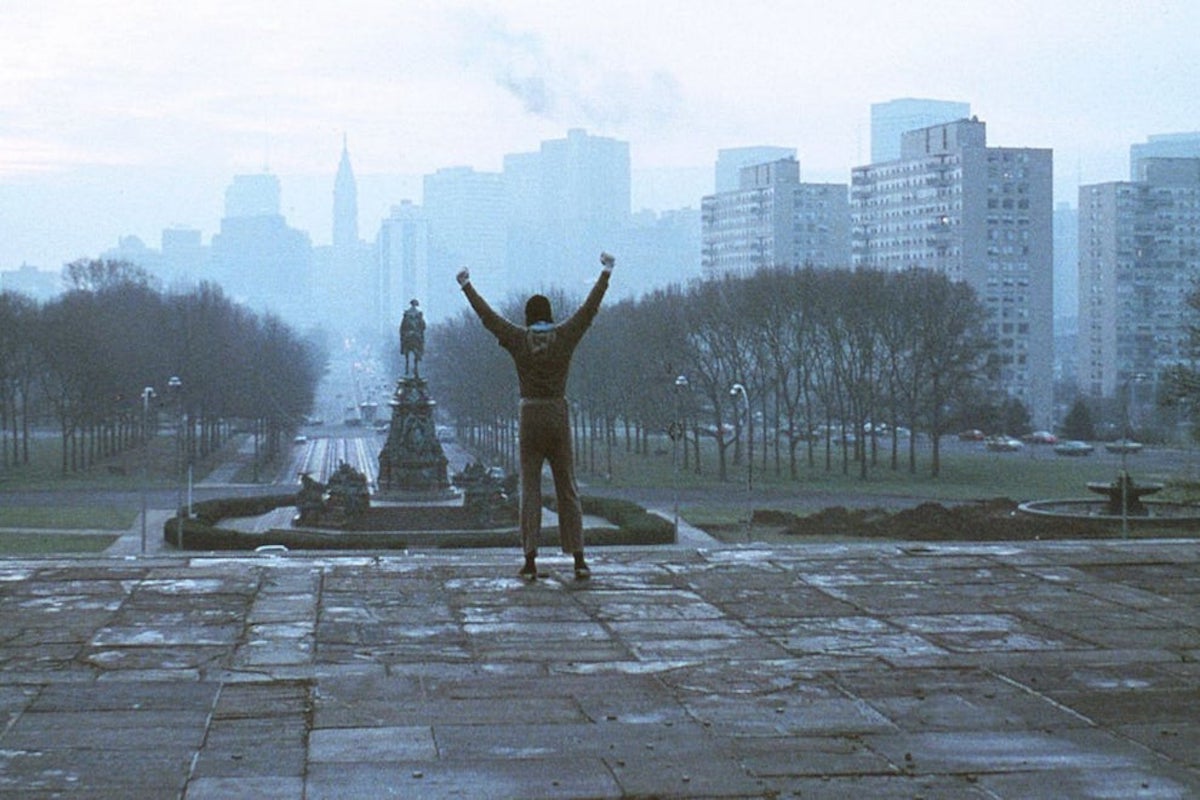New Year, New You? You’re Gonna Need a Montage (So Here’s Ten of the Best)

“Show a lot of things happening at once / Remind everyone of what’s going on / And with every shot show a little improvement / To show it all would take too long.”
The song “Montage” from 2004’s Team America: World Police neatly explains the editing technique of quick cuts between shots. And through puppets pumping iron to cheesy rock, Team America hilariously illustrates how using montages to fast-track training in films has become a ripe cliché: “Even Rocky had a montage.” More like six.
The first, 1976’s Rocky, is often wrongly credited as the first training montage ever, although it’s “certainly one of the most memorable and enjoyable” to Dr. Lindsay Steenberg, a senior lecturer in film studies at Oxford Brookes University. But training montages have been around at least as long as Hollywood has been knocking out boxing films: 1931’s The Champ is a favourite early film of Steenberg. War films, with their ragtag bands of misfits moulded into tight units, also contain some “treasures”.
Training montages found currency in the 1980s and the era of MTV when films increasingly featured pop songs. Music is a key ingredient in the secret sauce of the training montage, demarcating it as a special moment – particularly if the music is pop, not score. “Insulated units” of cinema that revolve around spectacle, training montages naturally lend themselves to online distribution as clips, says Steenberg, while their music finds its way onto our workout playlists. They’re “perfect pop culture trading cards”.
Part of the appeal of training montages is that we’ve seen the payoff. “We know the montage works and we can find inspiration by mirroring it in our own training,” says Steenberg, whose own workout playlist includes “You’re The Best” by Joe Esposito from the tournament montage in 1984’s The Karate Kid. (“Wax on, wax off” isn’t a montage, sorry.)

Training montages work on a number of levels. In her book The Joy Of Movement, Dr Kelly McGonigal, a research psychologist, and lecturer at Stanford University (as well as a group fitness instructor) explains how watching movement triggers “a sympathetic response”: your heart rate rises, and your premotor cortex fires. You sense the actions in your own body, which makes the experience not just visual but visceral.
Rooted in our mirror neuron system, this “embodied empathy” is an instinctive attempt to understand others and “surely part of the thrill of watching sports, dance or stunts”. As well as giving us pleasure, it also broadens “our own sense of what’s possible for ourselves”. Hashtag fitspo, as the ‘grammers would say.
Following American investment in “myths of individualism and meritocracy”, the main lesson from training montages, says Steenberg, is that “we have the power to make ourselves”, which “takes work and must be earned”. But hard-bodied self-determination can develop a heart-hearted lack of sympathy for others who are perceived as too lazy to do likewise, rather than disadvantaged.
Some scholars see training montages as a manifestation of “bio-power”, a celebration of the able, white, male body that casts a shadow over other and, the suggestion is, lesser bodies. But then these Nietzchean, if not tights-wearing, supermen are often perfectly sculpting themselves to fight tyranny and totalitarianism – conflicts Steenberg finds “infinitely fascinating”. It’s complicated.
Viewing Eighties action films in their cultural context of Cold War politics post-Vietnam and a backlash of ‘hard’ masculinity against feminism, Steenberg shows her students the training montage from 1985’s Rocky IV – but not as a cautionary tale.
Instead, she encourages them to think about what makes the “glorious and glittering cinematic jewels” that are training montages such a joy to watch, re-watch, share, and compile into top-ten lists. And she won’t deny jogging up the same steps in Philadelphia as Rocky “in reverent homage”. Training montages have the undeniable power to move us.
10 Of The Best Training Montages
Rocky (1976)
The iconic training montage and song: the opening trumpets of composer Bill Conti’s Academy Award-nominated “Gonna Fly Now” provoke a practically Pavlovian response to pull on grey sweats, go for a run, and punch meat.
“Power songs” that change our mood and physiology have strong “extramusical associations,” writes McGonigal: they trigger “positive emotions, images and meaning” based on personal memories, pop culture (if a song was the soundtrack to a film, for example), the performers or the lyrics. But “the most important” for pushing you are the words. “Gonna Fly Now” is, like Rocky, hard to beat.
Batman Begins (2005)
In his fascinating book Becoming Batman: The Possibility Of A Superhero, professor of kinesiology and neuroscience (and martial arts black belt) E Paul Zehr concludes that a traumatically orphaned billionaire could theoretically hone the Dark Knight’s prodigious skills and abilities, but it’d take the best part of two decades.
In this origin story, it takes Christian Bale’s Bruce Wayne about four minutes. But then his instructor is Liam Neeson. “The training is nothing,” says Ducard. “The will is everything – the will to act.” You’ll never skip a session again. All that’s missing is a killer song – like “Who’s The (Bat)Man”.
Kill Bill: Vol 2 (2004)
Under “The Cruel Tutelage of Pei Mei”, Uma Thurman’s relentlessly brutalised but never beaten Beatrix Kiddo is forced to carry water up steps, three-inch punch her way through a piece of wood, and – most challenging of all – eat rice with chopsticks. “It is the wood that should fear your hand – not the other way around,” says her uncompromising kung-fu master in this reverent homage to old-school martial arts films.
Indeed, Tarantino-level movie nerds will recognise beard-swishing Pei Mei as Gordon Liu, the trainee in Seventies chopsocky classic The 36th Chamber Of Shaolin. Speaking of which…
The 36th Chamber Of Shaolin (1978)
Named by cinema cognoscenti as one of the best action films of all time in Time, this influential kung-fu flick is also well-known among hip-hop circles for having inspired the lyrical vocabulary of seminal crew Wu-Tang Clan with its tale of Chinese villagers rising against Manchu oppressors.
Liu’s vengeful student joins a Shaolin temple where, in a six-minute sequence described by Empire as “one of the most awesome montages in movie history, and definitely one of the longest”, he works his way through the leg chamber, the sword chamber and the “using a staff to hit bags, pull big stone blocks and spin little metal discs without slicing your arm open on spikes” chamber.
Mulan (1998)
“Did they send me daughters, when I asked for sons?” wonders gratuitously shirtless captain Li Shang as he trains hapless Chinese army recruits to repel the invading Huns. If he knew that the one who kicks him onto his butt was really Fa Mulan, in disguise to save her elderly father from military service, he might’ve changed his tune: “I’ll Make A Man Out Of You”, a banger and, you suspect, a sneaky critique of masculine ideals.
Strength and discipline, symbolised by the weights that Mulan shimmies up a pole with to retrieve Li’s arrow, aren’t unique to men – nor how Disney’s anti-damsel saves the day.
Rocky III
A training montage cliché in themselves, Rocky and rival turned coach Apollo Creed’s beach sprints are set to “Gonna Fly Now” – not “Eye Of The Tiger”, which comes in an earlier, non-training montage.
Nevertheless, it’s scientifically proven that listening to “Eye Of The Tiger” can help you combat fatigue and have more fun doing so, no doubt partly due to “its association with a fighter who won’t quit and its lyrics about rising to a challenge”, as Dr McGonigal writes. To quote Survivor guitarist Frankie Sullivan: “It’s about saying: ‘I’m not going to try to go to the gym Monday – I am going to go to the gym Monday.’”
The Incredibles (2004)
In this short, sweet and very literal training montage, early-retired superhero Mr Incredible gets his fitness back on track after 15 years of domestication, by lifting locomotives. That not only stops his runaway middle-age spread, but also makes him a better husband and father.
Incredible, but true – a study cited by Dr McGonigal shows that exercise leads to positive social interactions with family and friends – which should help convince your partner of the need for “you time”. Another study showed that married couples who exercise together report higher “marital satisfaction”. Well, Elastigirl certainly seems happy…
Creed (2015)
Yes, another Rocky film. But this spin-off riffs on the formula to create something satisfyingly familiar yet exhilaratingly fresh, Michael B Jordan’s Adonis “Donnie” Johnson running through the Philly streets in grey sweats to Meek Mill’s “Lord Knows” with a nod to “Gonna Fly Now”.
And there’s an emotional one-two punch, Donnie confronting his destiny as Apollo’s son while Rocky faces his toughest opponent: cancer. “I usually did that with one hand,” he says as Donnie does press-ups on the hospital floor, elegiacally reminded us of the now-trainer’s own majestic prime, long passed.
GI Jane (1997)
In one of Steenberg’s favourite training montages, US Navy Intelligence officer Jordan O’Neil, the first woman to undergo gruelling selection for the fictional “Combined Reconnaissance Team”, masters one-arm press-ups to the ironic tune of “Mama Told Me Not To Come”.
Training montages have traditionally been reserved for male warriors, and the empowerment here is, Dr Steenberg says, limited by the eroticisation of Demi Moore’s body. But then men are also often eroticised, sometimes not so subtly, in training montages, which are “an alibi” for admiring their bodies. Equal opportunities, after all.
Rocky IV (1985)
Following the franchise, and indeed ’80s, diktat that bigger is better, this unapologetic piece of propaganda is perhaps the ultimate training montage – because it’s actually two. A great first track for a workout playlist, the slow-building “Training Montage” by synth maestro Vince DiCola takes Rocky from those tentative first steps out into the cold to what you think is a fist-pumping conclusion.
But that was merely the warm-up for “Hearts On Fire” by John Cafferty. Stairs? Pah. Here, Rocky runs up a mountain – in a shearling jacket and beanie. It’s almost impossible to watch this and not want to work out.


















